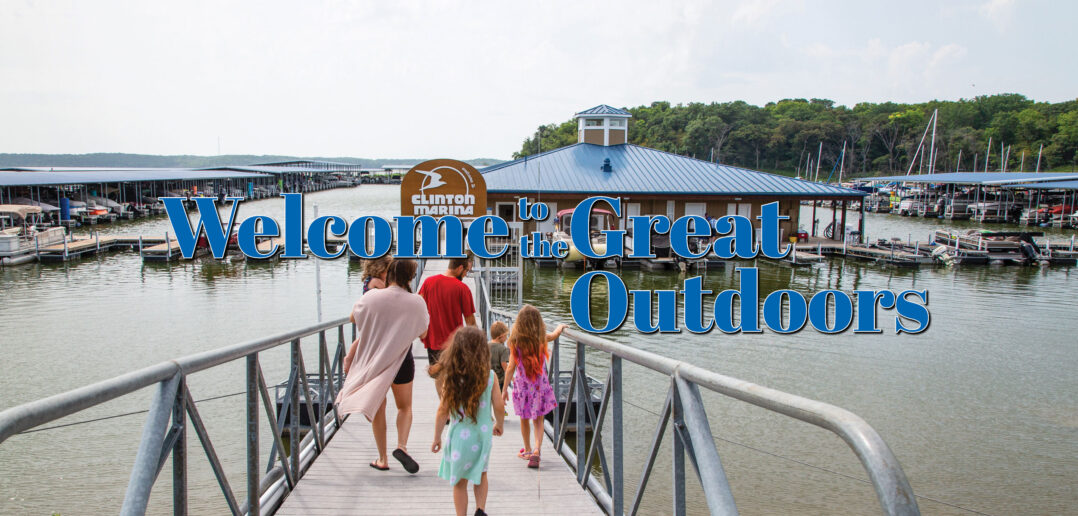| story by | |
| photos by | Steven Hertzog |
| OPEN A PDF OF THE ARTICLE |
Clinton Lake offers a treasure trove of outdoor activities for all community members, from the calm of trails underfoot and birds singing to the bluster of boats whizzing across the lake.
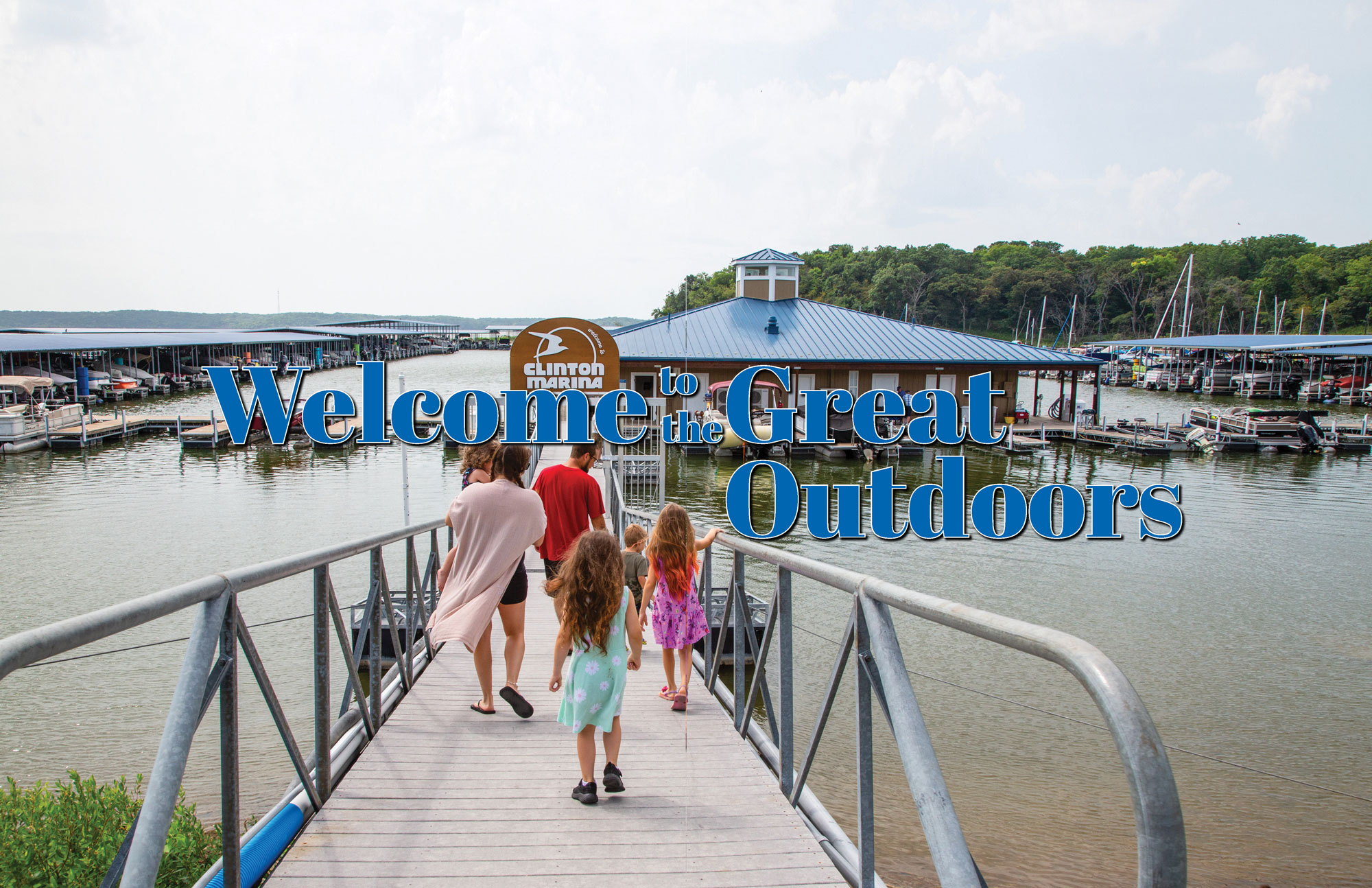
Welcome to the Great Outdoors
One may not enter Lawrence, Kansas, and think they’ve stumbled into an oasis for outdoor enthusiasts. We’ve got the cool downtown, the college, the history, the diversity. But head west across town, and you’ll run right into our hidden gem: Clinton Lake.
An integral part of surrounding communities, Clinton Lake is a reservoir lake southwest of Lawrence, Kansas, and the most relied-on reservoir in the state. Initially built to control flooding in the area and provide water to the city of Lawrence, it is the source of water for more than 100,000 people in northeastern Kansas. In the years since it was built, it has become a sanctuary for those who enjoy camping, hiking, biking, fishing, horseback riding and just plain being outdoors.
And being located near multiple universities doesn’t hurt. “While we thoroughly enjoy our regulars who have been coming for years, it’s fun to have new visitors who have not yet had the opportunity to experience Clinton Lake,” says Samantha Jones, natural resource manager, Clinton and Hillsdale Lakes, with the Army Corps of Engineers (the Corps). “This can come with complications, though, as we work to educate new visitors each year to the rules and regulations governing the lake for the safety of the people and the resources.”
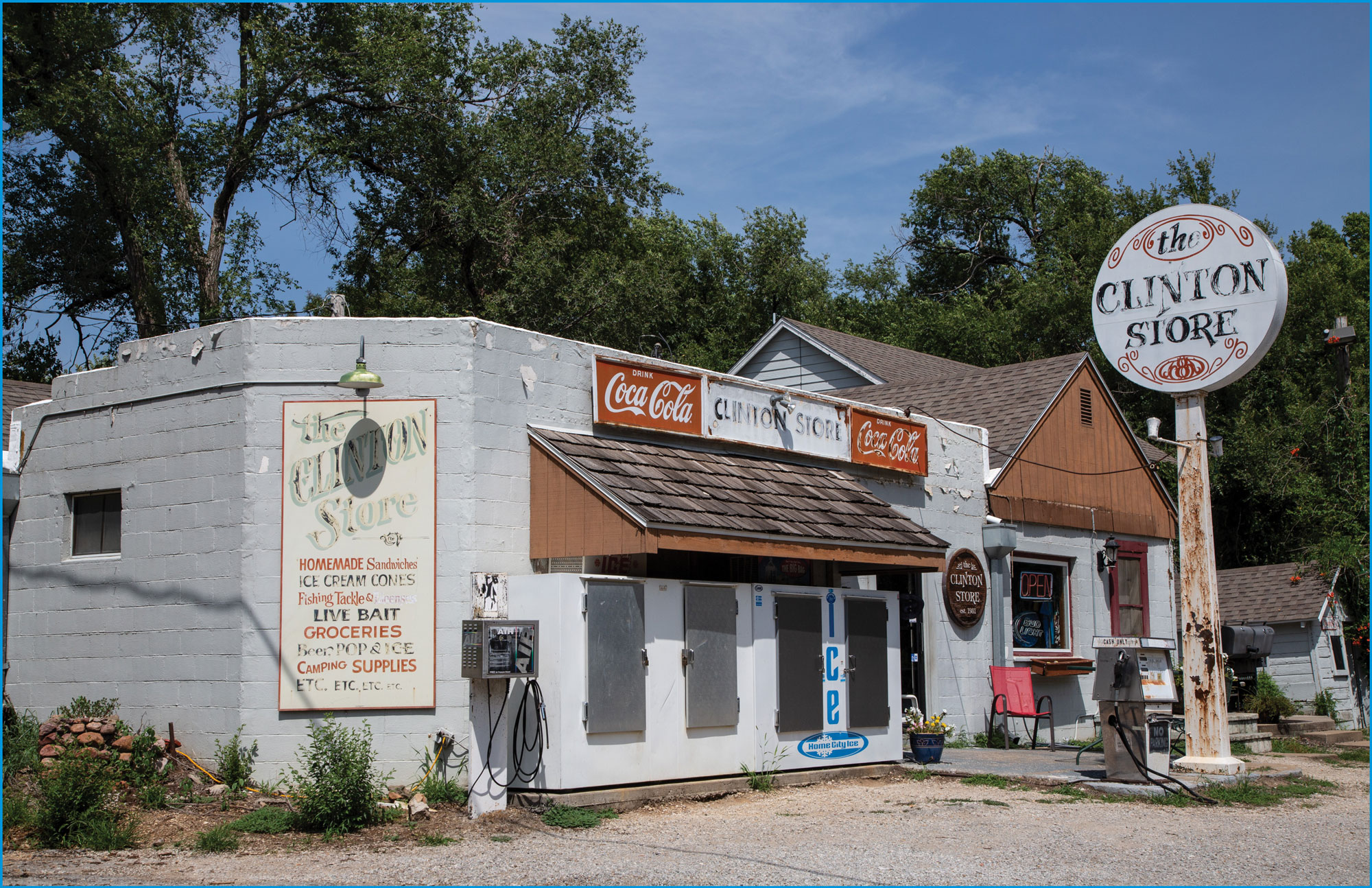
The Historic Clinton Store
The Early Days

Top to bottom: President of the Wakarusa River Valley Heritage Museum Marin Massa searches old photographs for the Lawrence Business Magazine; Visitors explore one of the many exhibits hosted by the Wakarusa Museum; The Museums outdoor patio hosts families, cook outs, concert and theater
The preliminary planning for the entire Wakarusa Watershed began in the 1950s, explains Marin Massa, president of the Clinton Lake Historical Society (CLHS), who helps run the Wakarusa River Valley Heritage Museum, which has a mission to preserve local Wakarusa Valley history, maintain the collection and educate the public about the historical importance of the Wakarusa River Valley. By 1960, the United States Corps of Engineers had proposed the dam across the Wakarusa River and Rock Creek, near Clinton, Kansas. The Flood Control Act was signed in 1962 to finance the purchase of land and the cost of the construction of the dam and reservoir.
By 1969, Richland, the western-most community the museum represents, had been vacated, and construction of the lake had begun, she continues. Land throughout the valley was slowly and methodically bought into the early 1970s. The Clinton Dam was completed by 1977, but it took several years for the lake to fill to normal pool level. The dedication of the lake was celebrated on July 4, 1980.
During construction of the reservoir, many agencies, including landowners, took into consideration any environmental concerns that might arise, Massa adds. An intensive archaeological and historical survey by the Iroquois Research Institute was also completed in 1976, documenting any archaeological sites in the Clinton Lake basin area.
“Domestic and industrial water supply, flood control, fish and wildlife preservation, soil conservation and recreation were the main factors for building the lake,” Massa says. “Some of these were problems to solve (like flood control), and others were potential future development (recreation).”
Jones says the initial purpose and mission of the lake have not changed. “But the methods of achieving those goals are dynamic as we adapt to changing needs of the public, weather patterns and evolving technology.”
For all of the reasons Clinton Lake was created, it “will become more and more important as human populations increase and weather patterns become more dynamic,” she continues. “These manmade lakes across the nation provide flood damage reduction, water supply, tourism and recreation opportunities for communities who otherwise may not have those resources.”
“While most people see the lake as only a place for recreation or a weekend escape,” Massa adds, “the importance of a safe water supply and flood control” will continue to be of the utmost importance.
It is estimated that Clinton Lake provided more than $827,500 of flood damage reduction in 2021 alone, Jones explains. The cumulative total for flood damage reduction since the lake was built is over $1.7 Billion. “Additionally, the lake receives over 1.5 million visitors each year, many of whom travel to the lake and aid in boosting the surrounding communities,” she adds.
Looking Ahead

The Historic Clinton Store
Jones says that today, Clinton Lake provides great green space, as well as lands and water the public can use and appreciate. According to a 1995 study by the National Wilderness Institute, the State of Kansas ranks last in the U.S. in percentage of public land, so these public lands are beneficial to the native flora and fauna, and they provide a much-needed location for outdoor recreation to the people of Kansas.
Though the lake does provide many positives for area locals, that was not the view of the residents during the years of lake construction. “It is never easy for families to lose their homes and their link to the land when it is taken away by imminent domain,” Massa says.
Throughout the reservoir planning process and construction, tensions ran high between the locals and the Corps, and groups formed so they could have a voice at the table, she continues. The lake’s impact to some of the communities was the destruction of their physical location, and many of the connections the communities had with each other were severed.
Being built in the 1970s, Clinton Lake is now dealing with aging infrastructure. But the biggest environmental issue, Jones says, is silt. The Corps has safeguards in place for daily operations and guidelines to aid in water-quality management. “Some of these practices include taking fields out of crop production and planting into hay fields, and disallowing hay or crop fields within a certain distance of any body of water or stream to ensure there is a buffer to trap sediments,” she adds.
Silt has also reduced the amount of storage capacity, which could affect the water supply and flood damage reduction capabilities in the long run. At this point, Jones explains, the lake has not reached a siltation amount that is yet greatly impacting the lake, but there are ongoing discussions to best determine methods of handling the silt. “Of course, an ounce of prevention is worth a pound of cure, so we need to stop the silt before it gets here to best manage the situation.”
Today, the Corps maintains the lake, the habitat, water storage and release, the campgrounds (in federal parks like Bloomington, Woodridge and Rockhaven), the trails, five campgrounds, three group camp areas and multiple day-use areas. As a federal lake, there is no private ownership of the shoreline, leaving it open to public hiking, fishing or hunting. The Outlet Park encompasses the areas where the water is released from the lake through the dam and flows back into the Wakarusa River.
Camping, boating, kayaking, trails (hiking, biking, trail running and horseback riding), birdwatching, beaches, disc golf and many more outdoor activities are offered throughout the lake and park.
The Corps works with the City of Lawrence, which leases much of the area below the dam for the Eagle Bend Golf Course, Arboretum, Youth Sports Complex, the paved trail through the spillway and the off-leash Mutt Run. “The City provides great services to lake visitors beyond what the Corps offers in our more traditional parks and wildlife areas,” Jones says.
It also collaborates with many other organizations in maintaining and improving the lake and its surrounding areas.
The Great Outdoors
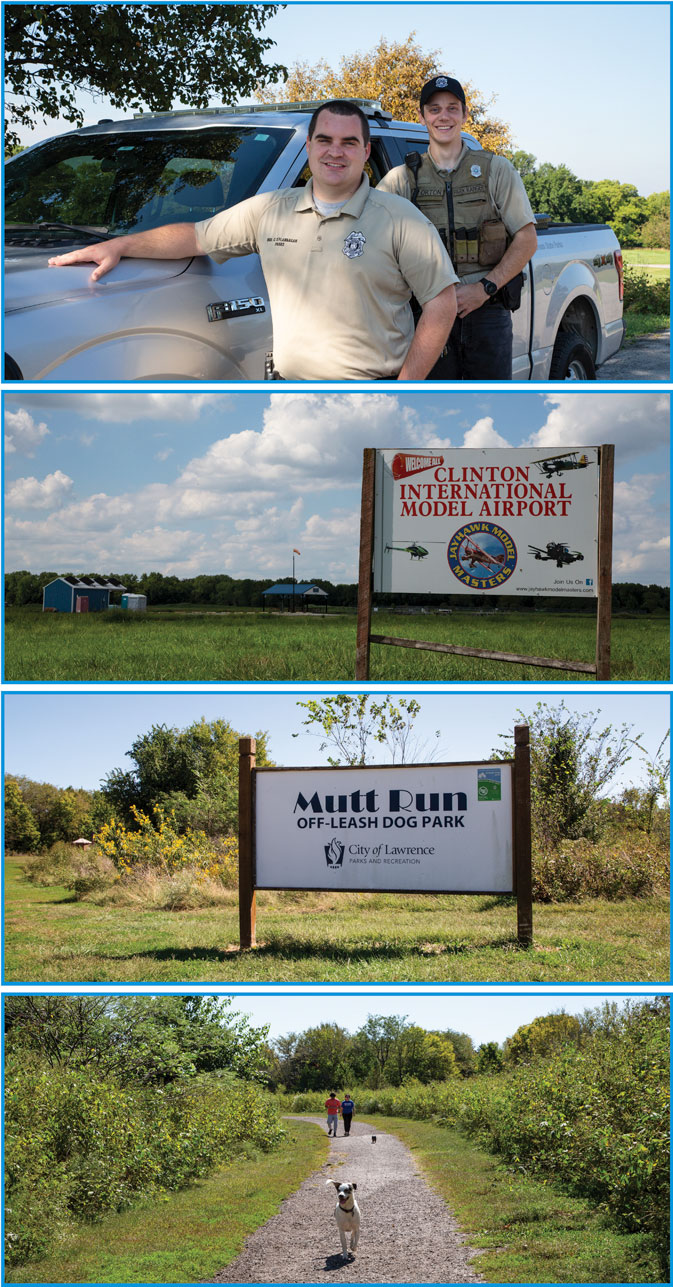
Top to bottom: Connor O’Flannagan, Park Manager and Chris Orton, assistant park manager; The Clinton International Model Airport and the Mutt Run
If being in the open air with your bike or your hiking boots is your thing, Clinton State Park is the place to be. Established in 1975, it is situated on the north side of Clinton Lake and “is Lawrence’s ‘backyard,’ ” explains Conner O’Flannagan, Clinton State Park park manager, with the Kansas Department of Wildlife and Parks (KDWP). The park was developed to expand the state park system, and the goal was to have state parks situated around the state where any citizen is within an hour’s drive of a park.
The Corps (federal government) owns the land upon which the park is situated, he adds. In the 1970s, KDWP leased the area on the north side and developed it into what has become Clinton State Park.
According to the Kansas State Parks website, the 1,500-acre park is known for its clear water and good fishing. It boasts modern facilities and an extensive hiking/biking trail system. Visitors may encounter white-tailed deer, wild turkey, waterfowl, bald eagles in spring and fall, and numerous species of songbirds in the park.
It offers boat ramps, courtesy docks, launching areas for windsurfers and personal watercraft, a beach with shower rinse-off station, picnic shelter areas, playgrounds, a sand volleyball area, an archery range, disc golf and more. The Clinton Reservoir is known for its white bass, channel catfish, walleye, wiper and crappie fishing. You can also find mudflats, drop-offs, river channels and rocks.
Today, the purpose of the state park is to provide a location with a multitude of outdoor recreation opportunities for all individuals to experience equally. “Clinton State Park offers these amenities on a completely equal platform,” O’Flannagan explains. “Nature and the outdoors is as equal as you can get. The outdoors does not care the color of your skin, your race, religion, creed, how you identify, who you are or even how you feel. It is going to treat you the same, and that is the beauty in it.”
Kansas State Parks are fee-funded, with a minimal amount of road money coming from the state, he explains. Operating budgets are in place but are dictated more on utilities such as water, electric and propane. “We operate on what we make, therefore camping fees, reservations and vehicle permits are the main source of income for the State Park system.”
However, the park is tied to a great deal of money that goes back into the local area, he continues. According to the Kansas State Parks Economic Contributions to Regional and State Economies study, the 2020 total number of visitors was 642,176, with the national average being about 450,000. There were 340 employees, and contributions to other park industries, including agriculture, mining, construction, manufacturing, trade, service and government, equaled $22,146,349.
Making Waves
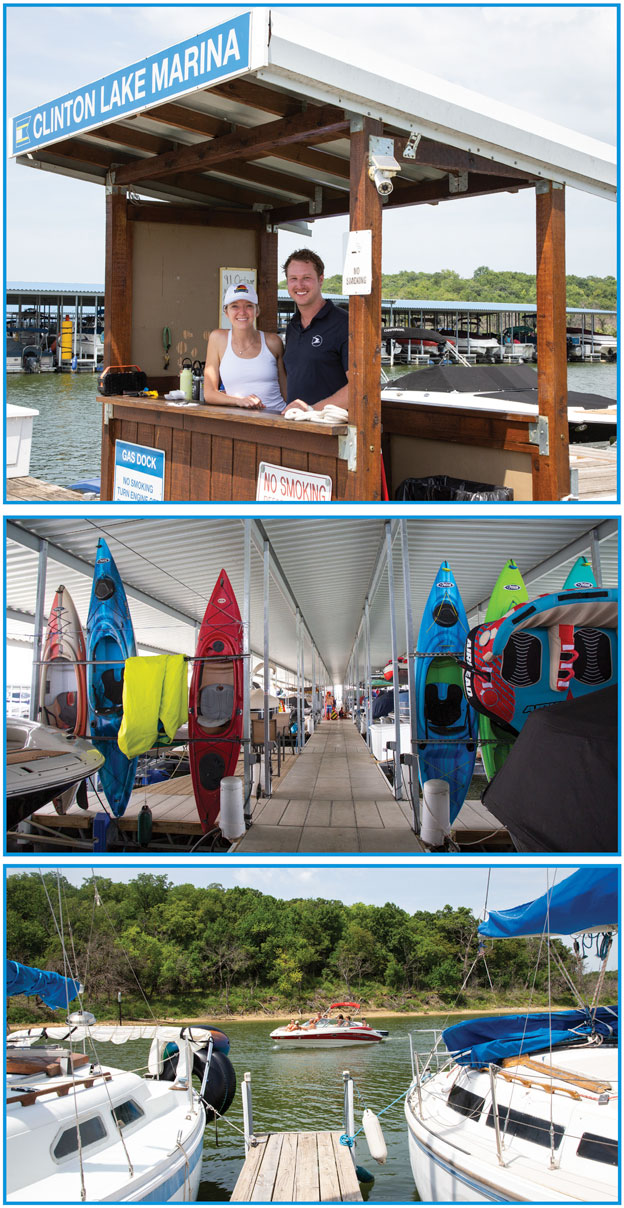
Top to bottom: Top to Bottom: Erin and Peter Meiusi, Owners of Clinton Lake Marina; Kayaks stored inside the boat slips; A boat cruises past two boats harbored in their slips
If boating and water sports are what make you happy, the Clinton Marina is where it’s at. Originally built in 1980 and located on the Corps property in Bloomington, on the west side of the reservoir, the marina was relocated to its current location, on the State Park shoreline, in 1986 to be closer to Lawrence, CLHS President Massa explains.
“Clinton Marina is one of the key elements of the social climate,” says Peter Meiusi, owner-operator of the marina, “whether it’s the meeting place for people before they head out to the lake, hang out at their slip or join us for one of our ‘Float Local’ parties.”
It is also vital for Clinton Lake’s economic stability. “In addition to staffing up to 30 people during the summer, we help support local breweries and brands with the products that we carry on our shelves,” he adds. “… we’re passionate about Lawrence, Clinton and the local market.”
The marina brings together people from different walks of life and allows them to find commonalities, adds Erin Meiusi, owner-operator and Peter’s wife. “From power-boaters, campers, fishermen, sailboaters, bird-watchers, hikers, our customers keep us constantly laughing and enjoying the lake.”
Initially opened in 1980 to provide boat storage, the marina now sells fuel, snacks and bait and tackle, has a deli, rents boats, offers a boat club and boat merchandise, and maintains a robust summer event schedule. “Boating trends have changed,” Erin Meiusi says, “allowing us to broaden our watersport items in the store to the newest boards and tubes.”
Marina customers include all demographics and socioeconomic classes, “something we take great pride in,” Peter Meiusi says. Roughly half of the customer base lives in Lawrence, with the remaining 50% coming from Overland Park, Johnson County and the surrounding areas.
“We have fishermen (and women) who have been fishing at the lake since it was developed,” Erin Meiusi adds. “We also have new families who are just getting into boating.”
The only marina in Kansas to provide a boat club, Clinton Marina is on the forefront when it comes to software and digital access for its customers. The No Coast Boat Club, Kansas City metro’s first boat club/boat subscription service, provides a unique, hassle-free boating experience.
“Boat ownership can be a hassle, so we launched the club to remove the friction of boating,” Peter Meiusi explains. The club purchased a wakeboard boat, tritoon and fishing boats, and club members have unlimited access to the vessels. The club is responsible for boat storage, maintenance, cleaning, insurance, purchasing of watersports toys and life jackets. Members simply make reservations and show up. “Our club boats-to-family ratio is roughly 40% lower than the national average, and club members even have access to all five of the marina’s rental boats.” Customized software allows members to select items such as pizza, beer, ice, etc., and have it waiting for them on the boat upon arrival.
The Meiusis feel the marina currently lacks a focal point, especially for those who don’t have a slip there. To address this issue, they plan to install a new 3,000-square-foot patio next to the marina store with furniture, lighting and speakers. They are partnering with the KU School of Architecture to design a new canopy for this space. “While we aim to continue to be family-focused and have zero intention of becoming a bar, we are also looking at options to add two or three draft beer heads so people can come hang out above the water and have a drink,” Peter Meiusi explains. “We envision live music and other patio events next year and beyond.”
Erin Meiusi says they plan to become more involved in the city of Lawrence as they grow and learn, and hope to continue to provide a sanctuary for citizens right in their own backyard. They are currently active in donating boat rentals and throwing free parties for the community with their “Float Local Friday” events.
“Clinton Marina provides not only a place to store and fuel your boat, but it provides a sense of community … ,” Peter Meiusi says. “Our customers are proud to be a part of Clinton Marina; it feels like one big family.”
A Most Precious Resource
Clinton Lake provides a valuable asset to the community, which, in turn, brings visitors and dollars to the area, adding even further support, the Corps’ Jones explains. “Ultimately, all the agencies and groups managing the lands and waters around the lake are working toward the same goal—protecting the people and the resources. So I believe we all work quite well together. As the landowners, we oversee the overall operations, but each other agency or group plays a vital role to help manage according to their specialty.
“Clinton Lake hosts a thriving community of outdoor enthusiasts. The lake is truly a community resource, (to) which we invite all to come enjoy in one fashion or another,” she adds. “The Corps of Engineers and all who help manage Clinton Lake do great work … fostering that love of the resources, which will encourage proper management of our shared resources for generations to come.”

